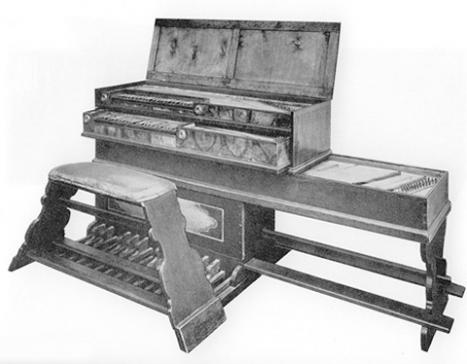Pedal clavichord

Pedal clavichord by Johann David Gerstenberg, Geringswalde (Saxony) 1760; Museum of Musical Instruments of the University of Leipzig
Such pedal clavichords were the classic practice instruments for mainly North and Central German organists. In fact, it consists of three individual instruments (one of which has particularly long strings and a pedal keyboard) that were placed on top of each other in a frame in such a way that they corresponded as precisely as possible to the keyboard of a two-manual organ with a pedal.
Music example:
Excerpt from Johann Sebastian Bach: Passacaglia in C minor BWV 582
played by Erik van Bruggen
Instrument: Dick Verwolf, copy of the pedal clavichord by J. D. Gerstenberg 1760"
The pedal clavichord is essentially a combination of several clavichords assembled in a special frame: two clavichords with manuals stacked on top of each other, plus a large-sized clavichord with a pedal keyboard. This forms an instrument that outwardly reveals its main purpose: it is a practice instrument for organists from a time when practicing in churches was hardly possible without electric heating or electric organ blowers. An organist required at least one calcant to pull or pump the bellows to be able to make music, who needed to be paid. Therefore, practice did not take place in the church but at home, where it was likely somewhat warmer. However, this required an instrument that at least approximately allowed for practicing both on multiple manuals and pedals.
In Germany and Northern Europe, a pedal clavichord was the most common practice instrument of this type. In the Romance countries, the use of harpsichords, which were occasionally built with an additional pedal keyboard in France, is documented. However, since pedal playing did not play a significant role in these countries anyway (the pedal keyboards often had only a limited range), organists could certainly manage without such an elaborate addition.
After 1800, when both the clavichord and harpsichord disappeared, some piano makers (such as Johann Schmidt in Salzburg) also produced a few pedal pianos, mainly as practice instruments for organists. Here, however, the problem was providing a second manual, which was never satisfactorily achieved. For this reason, such specialized instruments were scarcely built throughout the 19th century.



